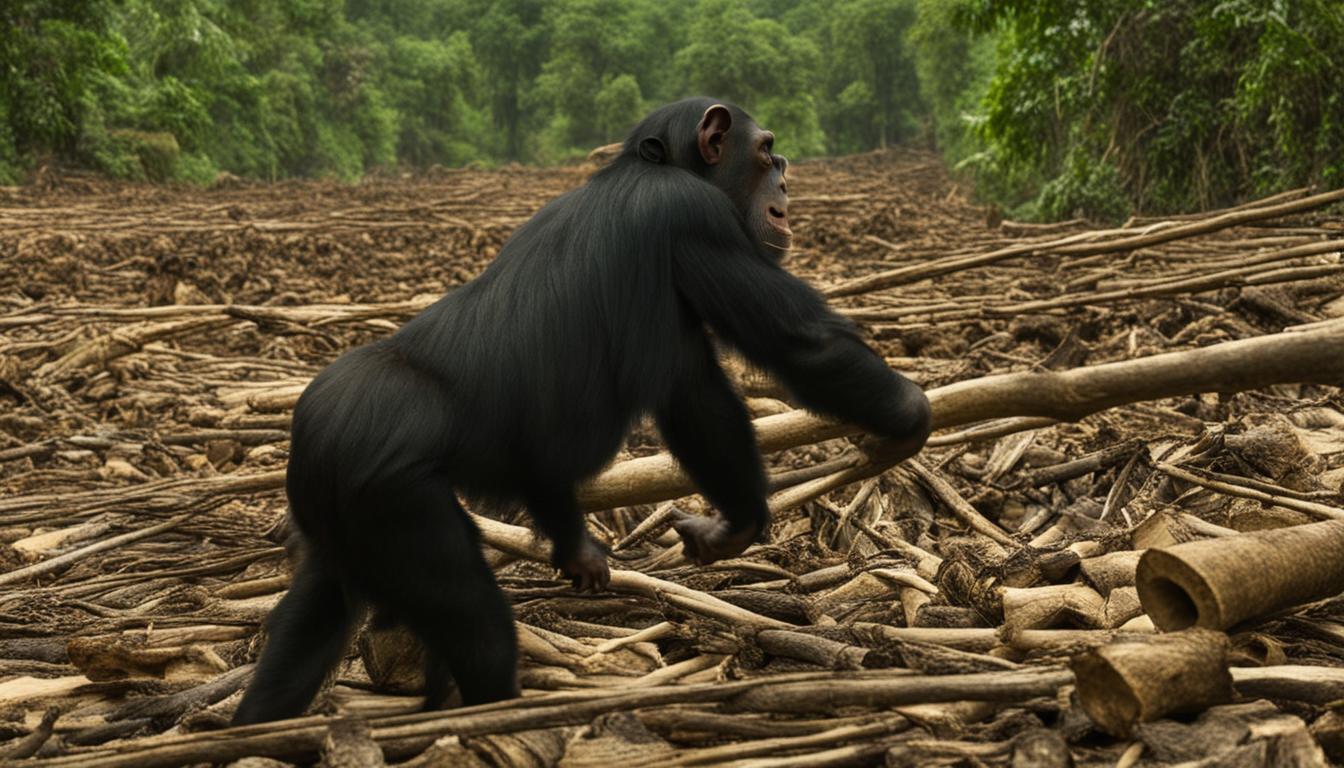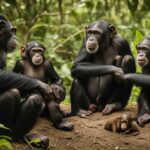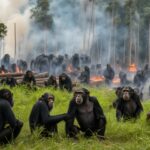If you’ve ever wondered about the natural habitat and geographic distribution of chimpanzees, you’ve come to the right place. Chimpanzees, our closest relatives in the animal kingdom, can be found in various parts of Africa. They inhabit forests and savannahs in tropical Africa, making them a crucial part of the region’s biodiversity.
There are four subpopulations of chimpanzees: the western chimp, the Nigeria-Cameroon chimp, the central chimp, and the eastern chimp. Each subpopulation has its unique characteristics and behaviors, adapting to the specific habitats they call home.
Chimpanzees have a thick black coat of hair covering most of their bodies, except for their face, fingers, toes, palms of the hands, and soles of the feet. They are incredibly well-adapted to their natural habitats, relying on their physical attributes for survival. Their geographic distribution is influenced by various factors ranging from habitat availability to human interference and conservation efforts.
| Threats to Chimpanzees | Impact |
|---|---|
| Habitat loss | Reduces space and resources for chimpanzees, increases vulnerability to extinction |
| Poaching | Depletes chimpanzee populations, disrupts social structures |
| Disease | Outbreaks can decimate populations, weakens resilience |
| Human-wildlife conflict | Increases the risk of retaliatory actions, endangers chimpanzees |
Solutions for Chimpanzee Conservation
To ensure the survival of wild chimpanzees, various conservation efforts are being implemented. These initiatives focus on key strategies that include habitat protection, anti-poaching efforts, community engagement, disease monitoring, and sustainable tourism.
Habitat Protection:
The establishment of protected areas and the enforcement of regulations are essential for preventing illegal logging and habitat destruction. By safeguarding the natural habitats of chimpanzees, conservationists can provide the necessary conditions for their survival and promote biodiversity.
Anti-Poaching Efforts:
Combatting the illegal bushmeat trade and protecting chimpanzees from hunting is critical for their preservation. Anti-poaching measures involve increased patrol and surveillance, as well as collaborations with local authorities to apprehend poachers and dismantle illegal market networks.
Community Engagement:
Engaging local communities in conservation initiatives is crucial for fostering positive relationships and ensuring sustainable practices. By involving communities in decision-making processes and providing alternative livelihood opportunities, conservationists can gain their support and reduce human-wildlife conflicts.
Disease Monitoring:
Monitoring and researching diseases that affect chimpanzees are vital for identifying potential threats and implementing necessary interventions. Regular disease surveillance helps prevent the spread of infectious diseases and allows researchers to develop effective strategies for disease management and prevention.
Sustainable Tourism:
Responsible chimpanzee trekking and sustainable tourism practices can generate economic benefits for local communities while supporting conservation efforts. By promoting ethical tourism experiences that prioritize the well-being of chimpanzees and their habitats, sustainable tourism contributes to the long-term conservation of these species.
These solutions for chimpanzee conservation combine various approaches to address the complex challenges faced by wild chimpanzee populations. Through collective efforts and a multi-faceted approach, we can secure a future where chimpanzees thrive in their natural habitats.
Chimpanzee Behaviors and Diet
Chimpanzees are fascinating creatures known for their complex behaviors and cognitive abilities. They possess a remarkable skill that sets them apart from other animals: tool use. Chimpanzees exhibit tool use in various ways, such as using sticks to extract termites from mounds or cracking open nuts with stones. This behavior demonstrates their problem-solving abilities and resourcefulness.
Chimpanzees live in social groups with a hierarchical structure, where males dominate the group. This social structure provides stability and order within the community. They communicate with each other through vocalizations, gestures, and facial expressions, allowing them to convey their intentions and emotions effectively.
As for their diet, chimpanzees have a diverse and adaptable palate. They consume a variety of foods, including fruits, leaves, insects, and even meat. Their diet varies depending on the availability of resources in their natural habitat. This flexibility enables them to survive in different environments and adapt to changing circumstances.
Another interesting behavior displayed by chimpanzees is their hunting behavior. While they are primarily herbivores, chimpanzees do engage in hunting, mainly targeting smaller mammals. They coordinate their efforts within the social group, employing strategic tactics to capture their prey. This behavior showcases their intelligence and adaptability as they exploit different food sources to meet their nutritional needs.
Chimpanzee behaviors and diet are intricately linked to their natural habitat and the availability of resources. Their ability to utilize tools, maintain complex social structures, and adapt their diet highlight the remarkable adaptability and intelligence of these incredible creatures.
Importance of Chimpanzee Conservation
Chimpanzee conservation plays a vital role in maintaining biodiversity and preserving the health of ecosystems. These intelligent beings serve as key contributors to their natural habitats by promoting forest regeneration and ensuring ecosystem balance. As indicator species, chimpanzees provide crucial insights into the overall health of their habitats. Protecting chimpanzees is not just about preserving a unique species; it is about safeguarding the well-being of ecosystems and the communities that depend on them.
One of the ecological roles of chimpanzees is seed dispersal. As they travel through the forests, they consume a variety of fruits and disperse the seeds through their droppings. This process allows for the regeneration of vegetation and contributes to the overall diversity of plant species in the area. When chimpanzee populations decline, the impact on seed dispersal can disrupt forest ecosystems, affecting plant growth and the wildlife that depends on these habitats.
Conservation efforts focused on chimpanzees also have positive impacts on local communities. By creating employment opportunities in eco-tourism, conservation initiatives contribute to the economic well-being of nearby communities. Engaging local people in sustainable practices ensures the long-term viability of the habitats that support both chimpanzees and human populations. It fosters a sense of responsibility and ownership, leading to improved conservation outcomes and a harmonious relationship between humans and wildlife.
The importance of chimpanzee conservation goes beyond preserving a single species. It is about recognizing the interconnectedness of all living beings and the intricate web of life that weaves together ecosystems and communities. By protecting chimpanzees, we not only protect their natural habitats but also contribute to the preservation of a healthy and thriving planet for future generations.
Are the Locations Where Chimpanzees Can Be Found in the Wild Threatened by Their Declining Population?
The locations where chimpanzees can be found in the wild are increasingly threatened by their declining population. With only an estimated 172,700 chimpanzees left in wild, ongoing habitat destruction, illegal poaching, and infectious diseases continue to pose significant risks to their survival in the wild.
What Causes the Decline in Chimpanzee Population in the Wild?
The decline in chimpanzees in the wild is attributed to habitat loss due to deforestation and human encroachment, poaching for bushmeat and the illegal pet trade, and diseases transmitted from humans. Climate change and natural disasters also impact their populations by altering their natural habitats.











